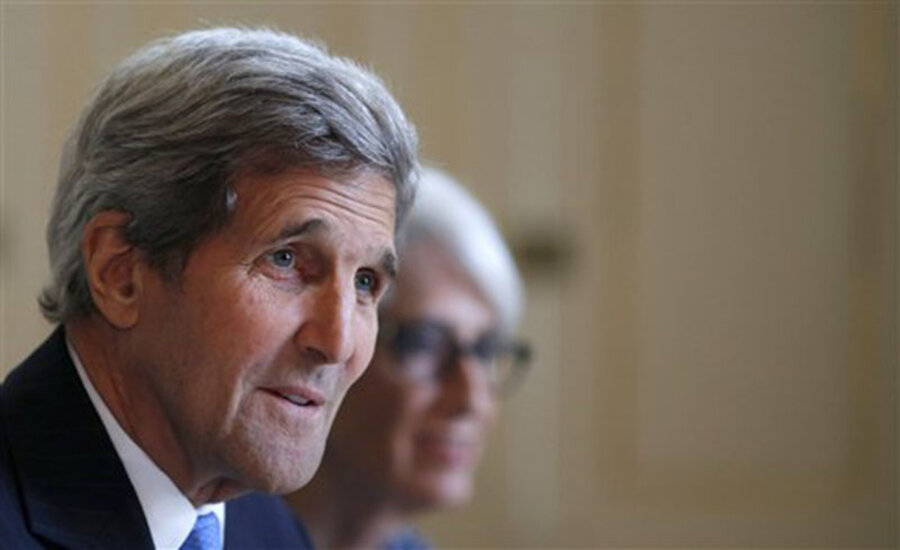UN report says Iran is on target to meet goals for cutting nuclear arms
Loading...
The UN’s International Atomic Energy Agency says Iran is broadly meeting its commitments under a preliminary nuclear deal that set the current talks in Austria on the path to a final agreement, according to The New York Times.
In agreeing to the November 2013 deal, Iran has pledged to not expand nuclear programs while negotiations are underway and to render harmless its stock of enriched uranium – uranium that is at levels just a technical step away from the form used in nuclear arms.
The Associated Press obtained the confidential report that was prepared by the UN’s atomic energy agency.
The report said more than four tons of the enriched uranium had been fed into a pipeline that ends with conversion of it into oxide, a material much less likely to be used to make nuclear arms.
A US official told the AP the US was satisfied that Iran met its commitments to reduce the amount of enriched uranium it stored.
The US and other countries have embarked on limited sanctions relief in step with Iran’s meeting of each commitment.
A Tuesday deadline was in place for Iran to work out a final deal regarding a peaceful settlement with the US, France, UK, Russia, China, and Germany but has been extended, as expected, to July 7.
Just a month ago, the same UN agency reported Iran’s stockpile at more than 8 tons, leading to fears it wouldn’t meet its target of a reduction to 7.6 tons.
Should Iran fail to deliver on its promises, the Obama White House has said that it is happy to make sure sanctions are “snapped back” into place.
According to Bloomberg, the UN Security Council will, as a safeguard, periodically approve a resolution maintaining sanctions relief. The resolution would allow a member state that has reason to believe Iran is violating the deal to block automatic rollover of relief.
The review would take place every six months or year and a dispute-resolution panel including Iran and the six powers negotiating the pact would examine any reported violations and issue non-binding decisions.
But a “snapback” would be “easier said than done,” Alex Vatanka from the Middle East Institute told Al Jazeera, because "it took about six years to put in place the massive international sanction regime Iran is under."
Sanctions typically include aid suspension, import and export bans, currency destabilization, prohibition of the ability to borrow, a ban on banks transferring loans across borders, and frozen assets.
The Pearson Institute for International Economics finds sanctions succeed in about one-third of cases overall but the rate depends on the type of objectives sought. They also note sanctions are more likely to be effective when goals are limited and clearly defined and targets are friendly or democratic countries.
In a blog post, Washington Post reporter Glenn Kessler said “in many ways, it is not the sanctions themselves but the ending of sanctions that is perceived to have the greatest impact.” He finds their main appeal is that they can signal resolve without bombs or troops.
A Congressional Research Service report found tough sanctions on Iranian trade have caused many private Iranian businesses to close, leaving about one in every five Iranian workers unemployed.
Iran has been hit by a wide combination of sanctions. Obama has focused on curtailing oil revenue and pressuring Iran’s access to international financial systems. Prior to 2012, half of Iran’s government revenues came from oil exports and comprised one-fifth of the country’s GDP. Since then, its oil exports have been cut off by more than half.
While Iran sold about 2.5 million barrels of oil a day in 2011, during the past year it has averaged just 1.1 million barrels a day, according to Kenneth Katzman, a specialist in Middle East affairs at the Congressional Research Service. Roughly half the decline resulted from sanctions by the European Union, which went from purchasing 600,000 barrels a day to almost zero. China and India, meanwhile, cut back their purchases of Iranian oil by a combined 31 percent in a show of support for US policy against Iran.
According to Al Arabiya, about $100 billion of Iranian assets have been frozen across the world under sanctions. But Iran said Wednesday that it recovered 13 tones of its gold reserves, which were initially frozen but released as a result of a compromise on the sidelines of Iran’s negotiations in Vienna.





